Are you planning for an outdoor getaway with your family and want to know how to easily fit an air mattress in a tent? You’re certainly not alone! Many people have struggled with this task due to the limited space inside a tent. But the good news is that there are some great tips and tricks out there that can make packing lighter, and fitting an air mattress into a tent, much easier than you think. In this blog post, we’ll go through all of the necessary steps to help you make the most of your camping experience by providing full information and useful tips on how to fit an air mattress inside a tent.
Why should you get an air mattress inside a tent?
Having an air mattress inside your tent can make camping much more comfortable. It’s easier to sleep on than a hard ground or sleeping pad and is much softer and more supportive. And, with a few extra steps, you can easily fit an air mattress in most tents for extra comfort during your camping adventure.
An inflatable air mattress also helps prevent the cold ground from transferring heat away from your body while you’re sleeping, which means you’ll stay warm throughout the night. Plus, it will help reduce the noise of any bumps or rocks in the ground that could otherwise keep you awake. All these benefits add up to a better overall experience when camping out!
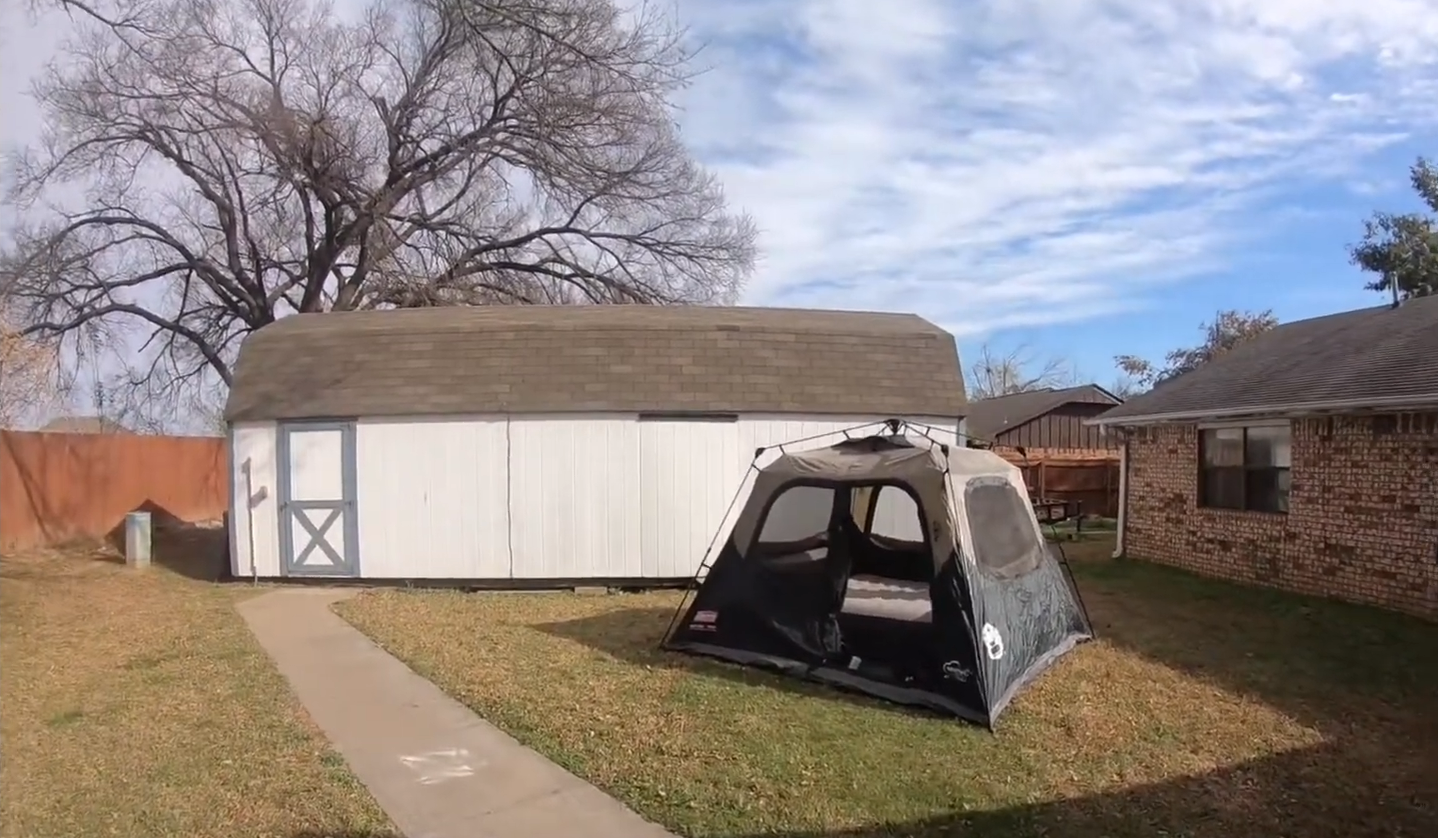
It will keep you warm and dry
If you’re looking for a way to stay warm and dry while camping, an air mattress inside a tent is the perfect solution. Not only does it provide insulation from the cold ground below, but it also helps keep moisture out. You can even get an extra layer of waterproofing with a special cover or liner designed specifically for air mattresses.
The great thing about using an air mattress in your tent is that you can adjust the height and firmness to suit your needs. It’s easy to find one that fits just right – all you have to do is measure the dimensions of your tent and then buy one accordingly. The best part? Most mattresses come with built-in pumps so you won’t have to worry about lugging a bulky external pump with you on your trip!
When you’re ready to hit the sack, don’t forget to bring comfortable blankets and pillows along for extra warmth and comfort. And if there are any gaps between your tent walls and air mattress edge, simply fill them in with additional blankets and pillows. This will further help keep you warm and dry during your snooze time!
It will provide a comfortable place to sleep
Fitting an air mattress inside a tent can be a great way to make your camping experience much more comfortable. With the extra height and padding provided by an air mattress, you won’t have to worry about sleeping on the hard ground or having back pain in the morning. Plus, with its built-in insulation, your air mattress will keep you warm throughout the night!
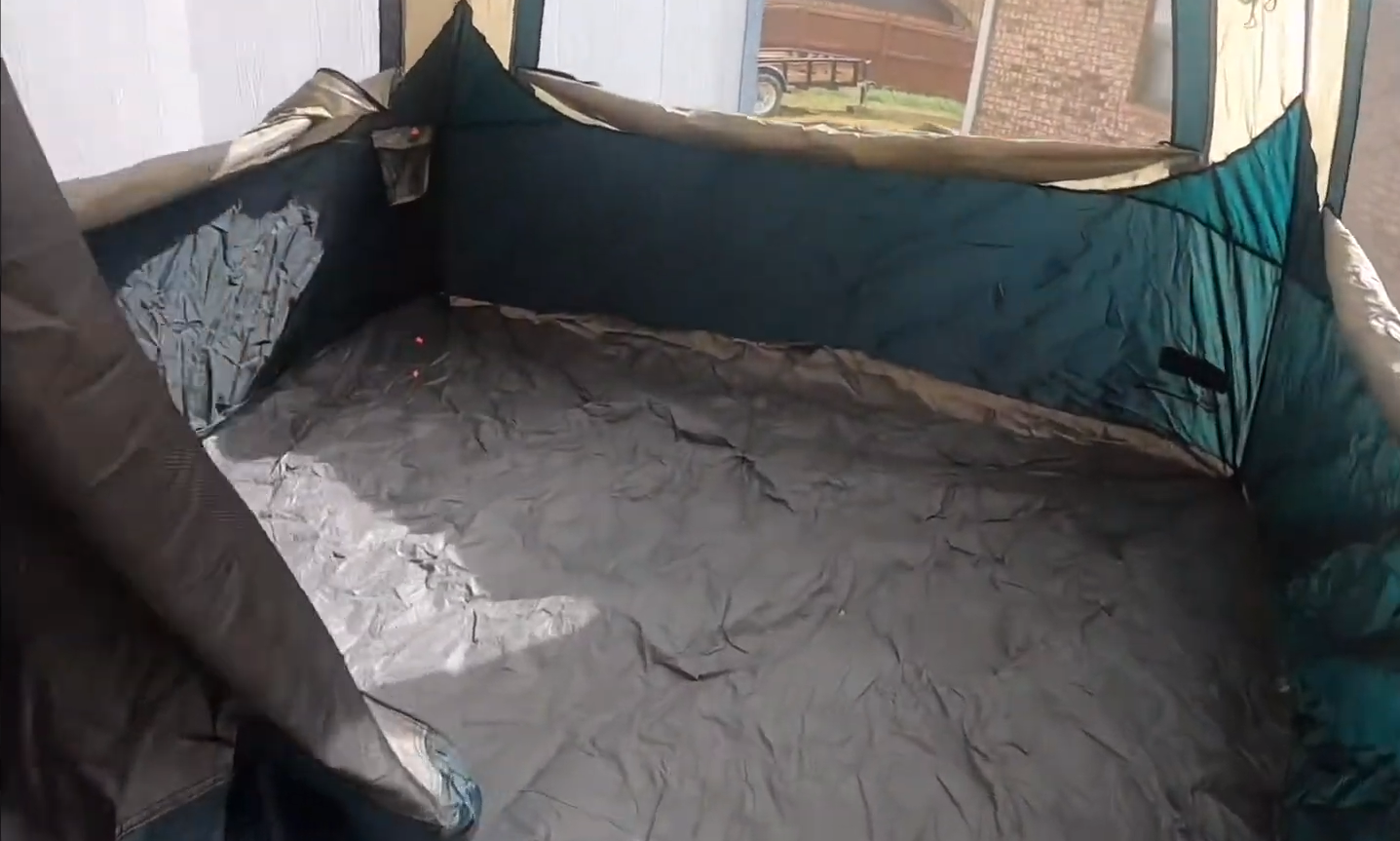
It is easy to set up
Setting up your air mattress inside a tent is relatively easy. All you need to do is make sure that the ground inside the tent is flat and free of debris, and then lay out the air mattress accordingly. Make sure to use a self-inflating pad or an inflatable pump to fill it up before putting it in the tent. It may take some time to get the mattress all set up, but it will be worth it once you have a nice comfortable place for sleeping!
It is lightweight and portable
An air mattress is a great investment for camping, as it’s lightweight and portable. You can easily fit your air mattress into the trunk of your car when you are heading out on an outdoor adventure. It’s also much more comfortable than sleeping on the ground, making it a must-have accessory for any camping trip.
It is affordable
An air mattress is comfortable to sleep inside a tent with an air mattress. However, it can be tricky to fit the mattress into the tent as tents are usually smaller than beds. Here are some tips for fitting an air mattress in a tent:
- Choose the right-sized air mattress – You should select an air mattress suitable for your tent size. It is best to find one that is slightly shorter than the length of your tent so that there is no risk of overhanging at either end.
- Consider getting an inflatable bed frame – Inflatable bed frames provide extra sleeping space and support for your air mattress while preventing it from sliding around inside the tent. They also help keep you warm by insulating the ground beneath you.
- Seal off any gaps – If your air mattress does not quite fit in the tent, try sealing off the gap between the air mattress and the side of the tent with a plastic sheet or tarp.
- Choose an air mattress with built-in insulation – Insulated air mattresses are designed to keep you warmer than regular ones by trapping body heat within their chambers. They can be easily fitted into a tent as they do not take up extra space as other sleeping pads may do.
- Place a blanket at each end of the mattress – Placing a blanket at each end of your air mattress will provide extra insulation and help keep you warm while sleeping inside the tent. [1]
Types of Air Mattresses
The style of air mattress you use may have a big effect on the size that will fit in your chosen tent. You can find four diverse types of air mattresses: classic, raised or integrated, pillow-top and inflatable cots.
Classic air mattresses are usually made from vinyl and feature traditional inflation valves. They come in several sizes and shapes and often weigh around 4 pounds for a queen size. While they provide comfort with their cushioning foam layers, these beds are often not as supportive or durable as other styles.
Pillow-top air mattresses feature a top layer of memory foam or polyfoam that adds extra comfort and cushioning. They often weigh around 10 pounds for a queen size but can provide more luxurious sleeping surfaces compared to other types of air mattresses.
Inflatable cots provide another way to bring additional comfort when fitting a mattress. While they may not provide as much cushioning as the above-mentioned styles, inflatable cots do offer a great way to keep the mattress elevated off the ground. They’re usually around 4-6 pounds lighter than classic air mattresses, making them an ideal choice for camping trips where weight is an issue.
Ensure the mattress fits inside your tent before you head out on your trip. If you can’t get it in, try a smaller size or a different style and see if that works better.
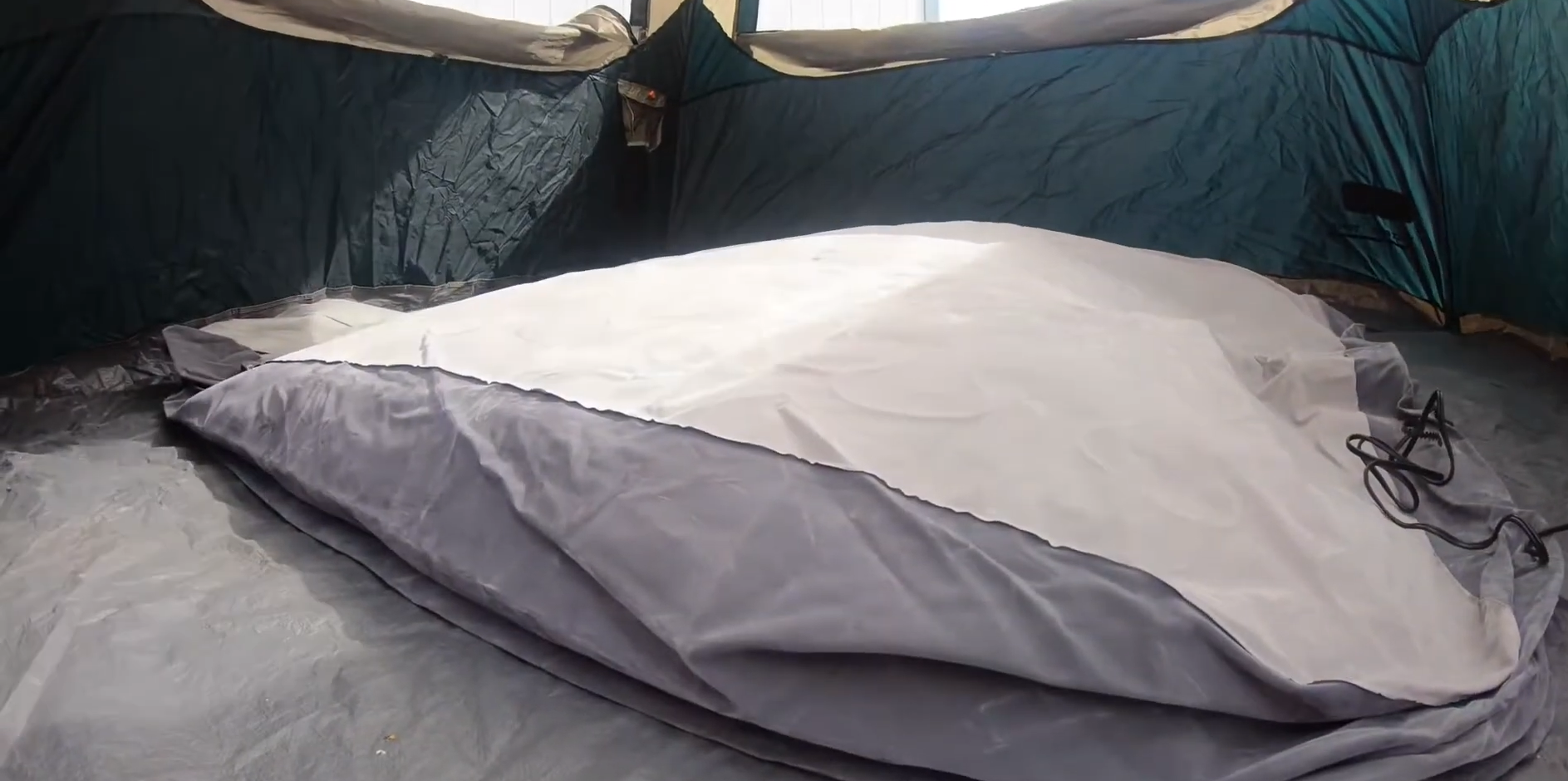
Single-Person Air Mattress
Fitting a single-person air mattress inside a tent can be a bit of a challenge, but with the right preparation and techniques, you can make it work. Here are some tips to help you out!
- Choose the right size air mattress. Ensure that your chosen air mattress fits snugly into your tent; if not, select one that will. You should also try to buy an air mattress that is as thin as possible, to give yourself more space within the tent and reduce bulkiness.
- If necessary, secure your air mattress down. Air mattresses tend to move around quite easily due to their lightweight design – especially in windy conditions – so it’s worth using tent pegs or other camping items to secure it in place.
- Utilize the sides of the tent and keep the mattress away from them. By doing this, you’ll give yourself more room to move inside the tent and reduce overall bulkiness.
- If possible, try inflating your air mattress inside the tent before securing it down. Featuring a rough estimation of where best to position it for maximum comfort and space-saving!
- When packing away, deflate your air mattress first and store it somewhere safe until you’re ready to go home again. Once deflated, it should be much easier to fit the mattress back into the tent and fold it away securely.
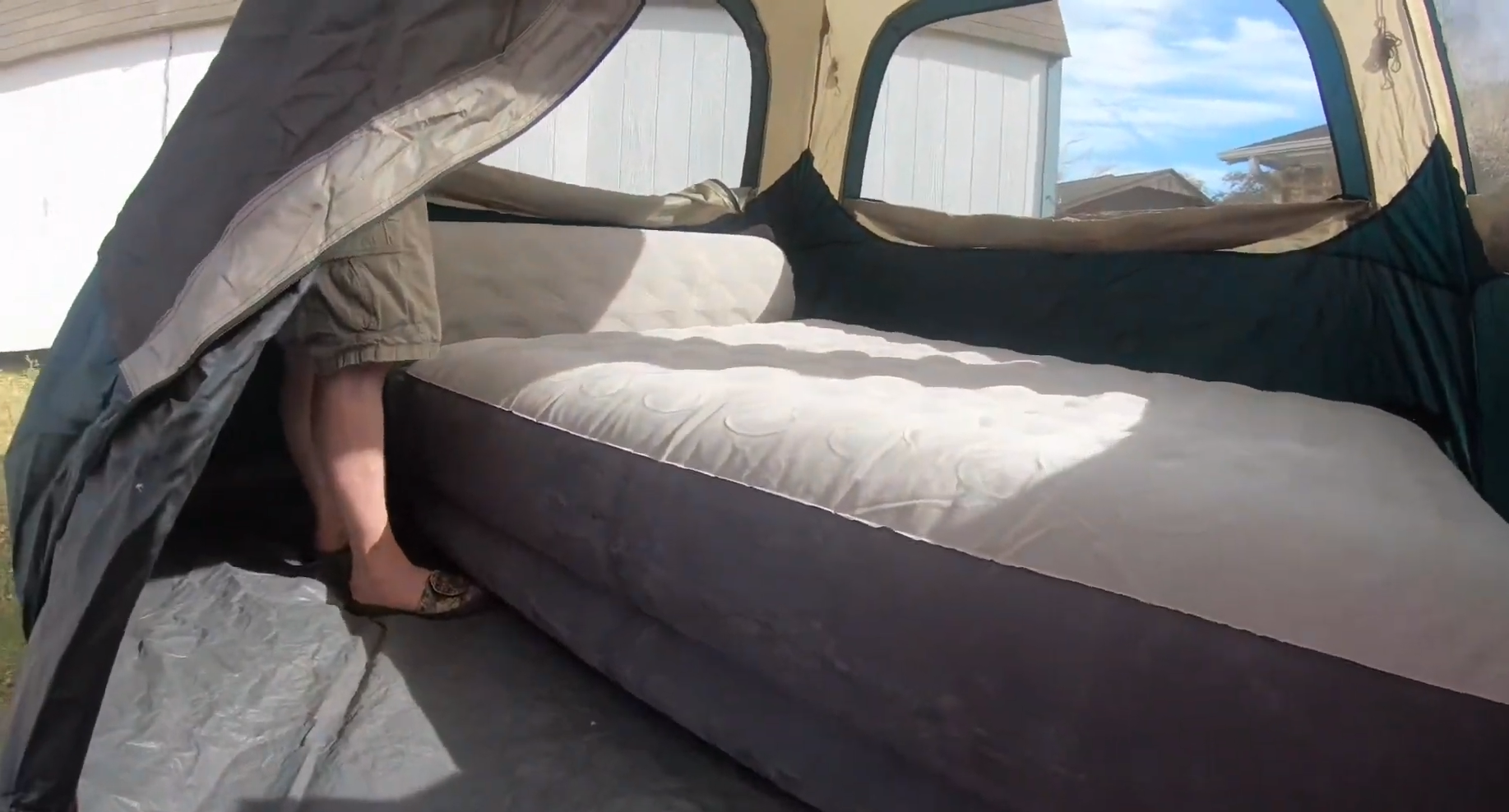
2-Person Air Mattress
If you are looking to fit two people in your tent, then a 2-person air mattress is the way to go. It will offer more room for two people and fit perfectly into most tents. Make sure that your tent has enough internal space to accommodate the size of the mattress before making a purchase.
Ensure that you leave some extra space around the edges to allow room for movement. This will also help keep the sides of your tent from being pressed inwards by the weight of the mattress. After inflation, secure any straps or elastic bands and tuck away any excess material to ensure a snug fit inside your tent.
Finally, always check to make sure that no part of the mattress is poking out from underneath the walls of your tent – this could potentially create an uncomfortable sleeping environment as well as increase moisture build-up during wet weather conditions.
Queen Size Air Mattress
First and foremost, ensure the mattress is properly sized for your tent. It should be no bigger than two-thirds of the floor space available inside the tent. If possible, also opt for a mattress that’s designed specifically for camping tents.
Begin by inflating it fully outside of the tent. Many models come with their own built-in pumps, so you don’t have to worry about finding a separate one. It’s important to note that it should fit snugly against the tent walls and edges without any extra space; this will help keep it secure while in use.
Ensure all necessary stakes are firmly secured and check that everything is stable before bedding down for the night.
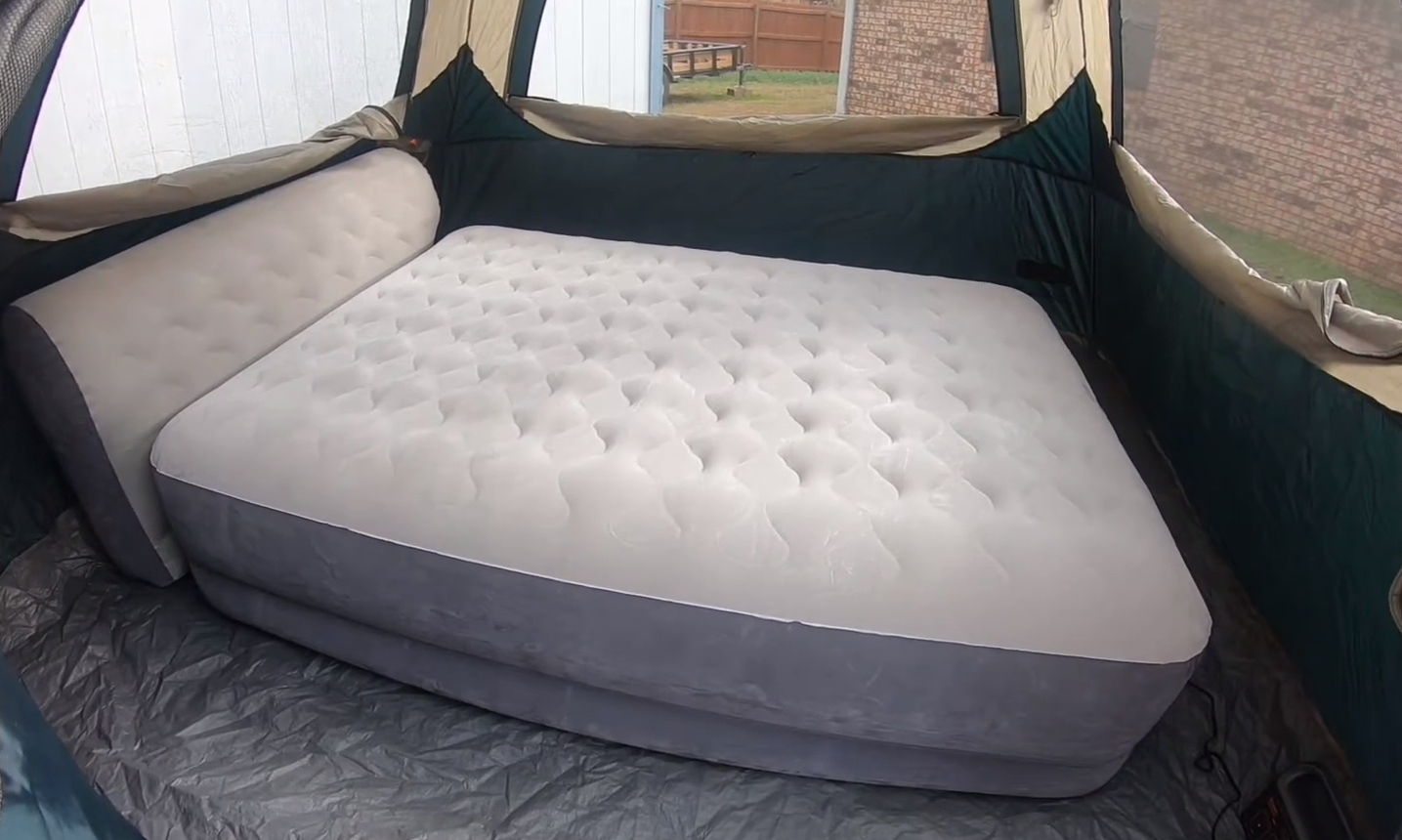
King Size Air Mattress
The rule of thumb is that you should leave at least six inches of space between the sides of the mattress and the walls of the tent for air circulation.
Check if any extra accessories such as an electric pump or adapter are needed — these can take up more space than you may expect.
If your tent is not equipped with a built-in insulation system, look for an air mattress that offers good insulation properties.
Finally, it’s always a great idea to add some kind of cushioning between you and the cold ground — think blankets, carpets or even sleeping mats! [2]
How To Fit An Air Mattress Inside A Tent
Fitting an air mattress inside a tent can be tricky, but with these helpful tips and tricks you should have no problem getting it in there! Here is what you will need:
- An air mattress (preferably one that’s made for camping)
- A pump or inflation device of your choice
- A tent big enough to fit the mattress comfortably
- A flat surface or groundsheet for the base of the tent.
Now let’s get started!
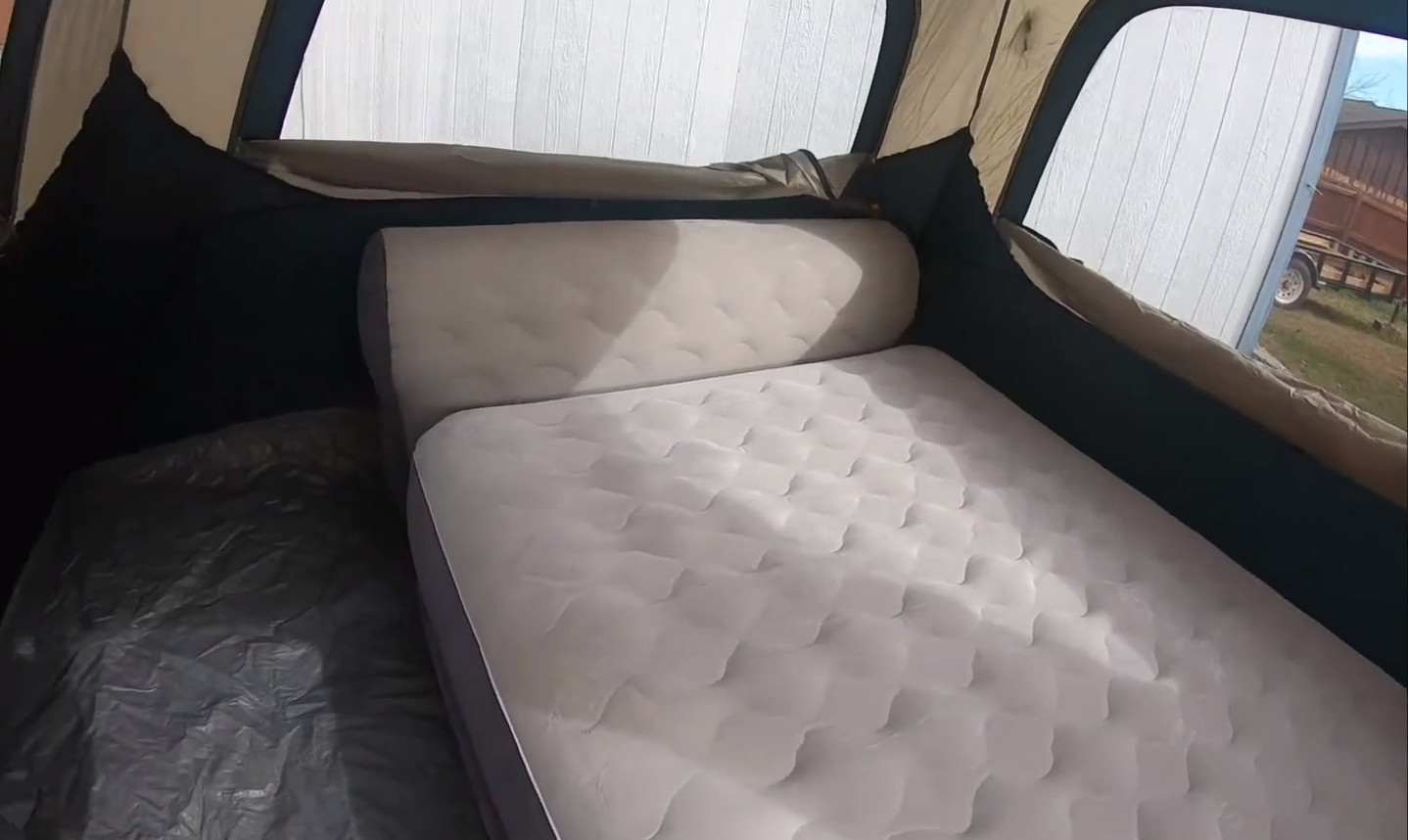
Deflate The Air Mattress
It is important to deflate the mattress before you attempt to fit it inside your tent. This will make the process much easier and faster, as an inflated mattress can take up a lot of space. Deflating it will also help prevent any possible damage while attempting to squeeze it through the entrance of your tent. To do this, simply open the valve located on the mattress and press down on different sections until all of the air has been completely released. Once done, roll or fold up the mattress to ensure that you don’t waste any precious space in the confines of your tent.
Roll Up The Air Mattress
With an inflatable mattress, you should roll it up tightly in three directions – lengthways, widthways and then again lengthways. This will reduce its size making it easier to fit inside a smaller space like a tent. Ensure the rolled-up mattress is secure before attempting to move it into the tent.
Place The End Of The Air Mattress Inside The Tent
Before doing this, ensure that there is enough room for you and your camping gear. Place one side of the mattress near the bottom of the tent and unroll it until it reaches either side or wall of the tent. Ensure that it doesn’t stretch beyond what’s comfortable for you and your fellow campers – otherwise, you won’t be able to get in and out easily! If necessary, cut off some excess material from around the edges. Be sure not to cut too much as this will reduce support when sleeping on it.
Push The Air Mattress Up Against The Tent Wall
Ensure that you are not putting too much pressure on any particular area – if there is too much strain it can cause damage to both your air mattress and your tent.
Once you have pushed as much of the mattress up against the wall as possible, secure it in place by using straps or bungee cords around both sides. This will keep it from slipping and sliding while you’re trying to fit in all your other camping gear!
Finally, once your air mattress is in place and secured against the wall of the tent, take a few moments to double check that everything looks secure. This will ensure that any movement during the night won’t cause your mattress to shift around wildly! And you’ll be all set for a comfortable night’s sleep.
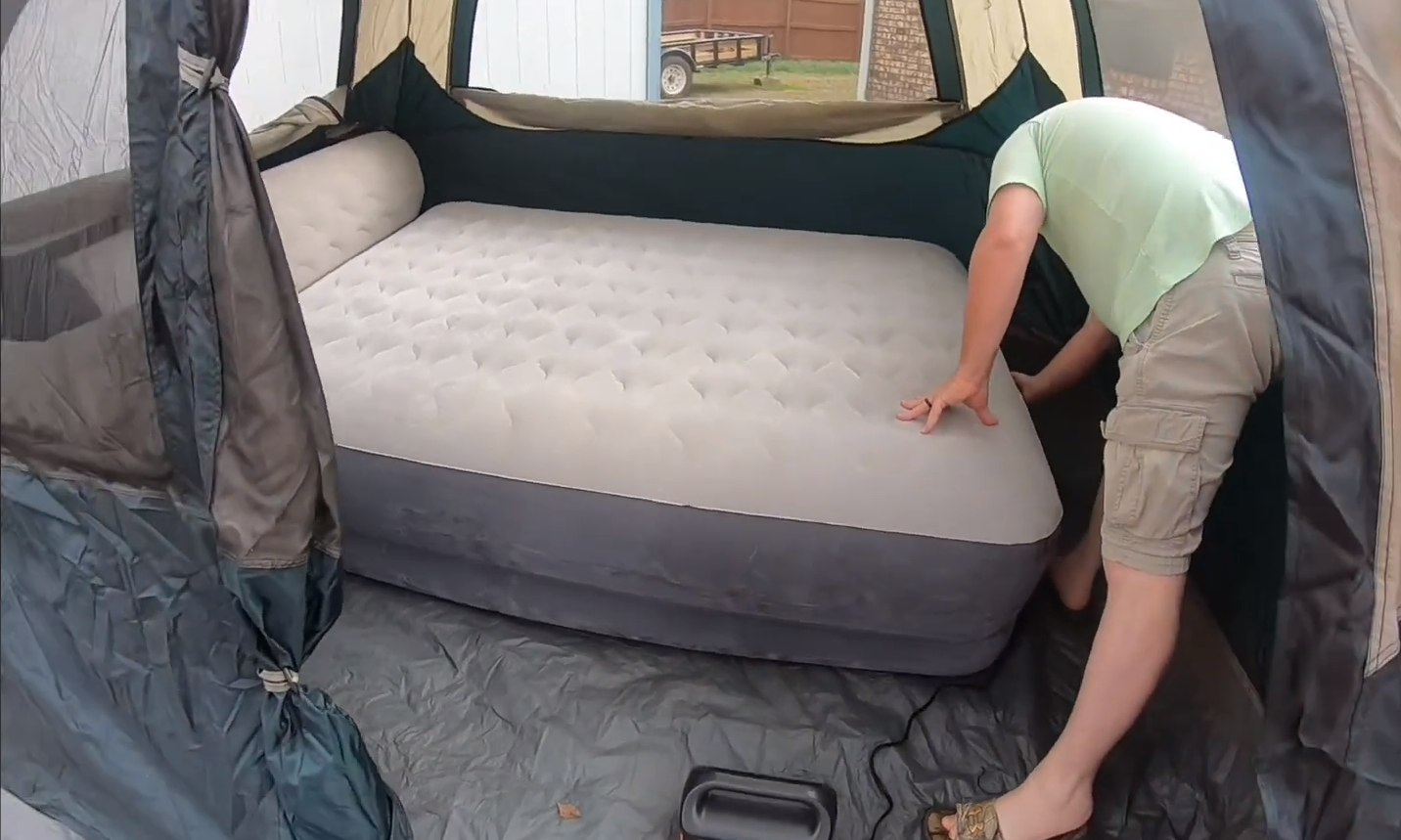
Repeat These Steps For The Other End
When you have secured one corner, repeat the same steps to secure the other corner. If you are using poles for additional support, make sure that those too are snugly fit in place.
Then, cut off the extra fabric from both ends and lay down a ground sheet at the bottom of your tent. This will protect your air mattress from any potential tears or puncture marks caused by sharp objects present in the ground or floor.
Put The Cover On Top Of The Air Mattress
Once you have the mattress, the next step is to put a cover on top of it. This will help provide additional padding and protection for the air mattress. The cover should be made from breathable material. If you plan on using an electric pump, ensure that the material won’t conduct electricity as well.
Once you have everything inside, all that’s left is to inflate it! Depending on what type of pump you have (manual or electric), follow the instructions for inflation provided with your equipment. Ensure that all valves and connections are secure before use; you don’t want any unexpected “leaks” while you’re trying to sleep!
Put A Sleeping Bag Over The Air Mattress
If there’s still some excess space left after fitting in the mattress and sleeping bag, use some extra blankets or pillows to fill in those spaces. You can also roll up clothing items such as coats or jackets into a ball and stuff them into nooks and crannies to help fill excess space. Doing so will ensure that there are no gaps left between the mattress and the walls of the tent, thus making it much more comfortable for you during your sleep.
Finally, make sure to close off the tent properly once you’re done fitting in the mattress and all other items inside. This will not only keep out drafts but also help to maximize the available space within your tent. Additionally, be sure to use a sleeping pad or cushion if needed – this can provide additional insulation against cold temperatures from seeping into the mattress.
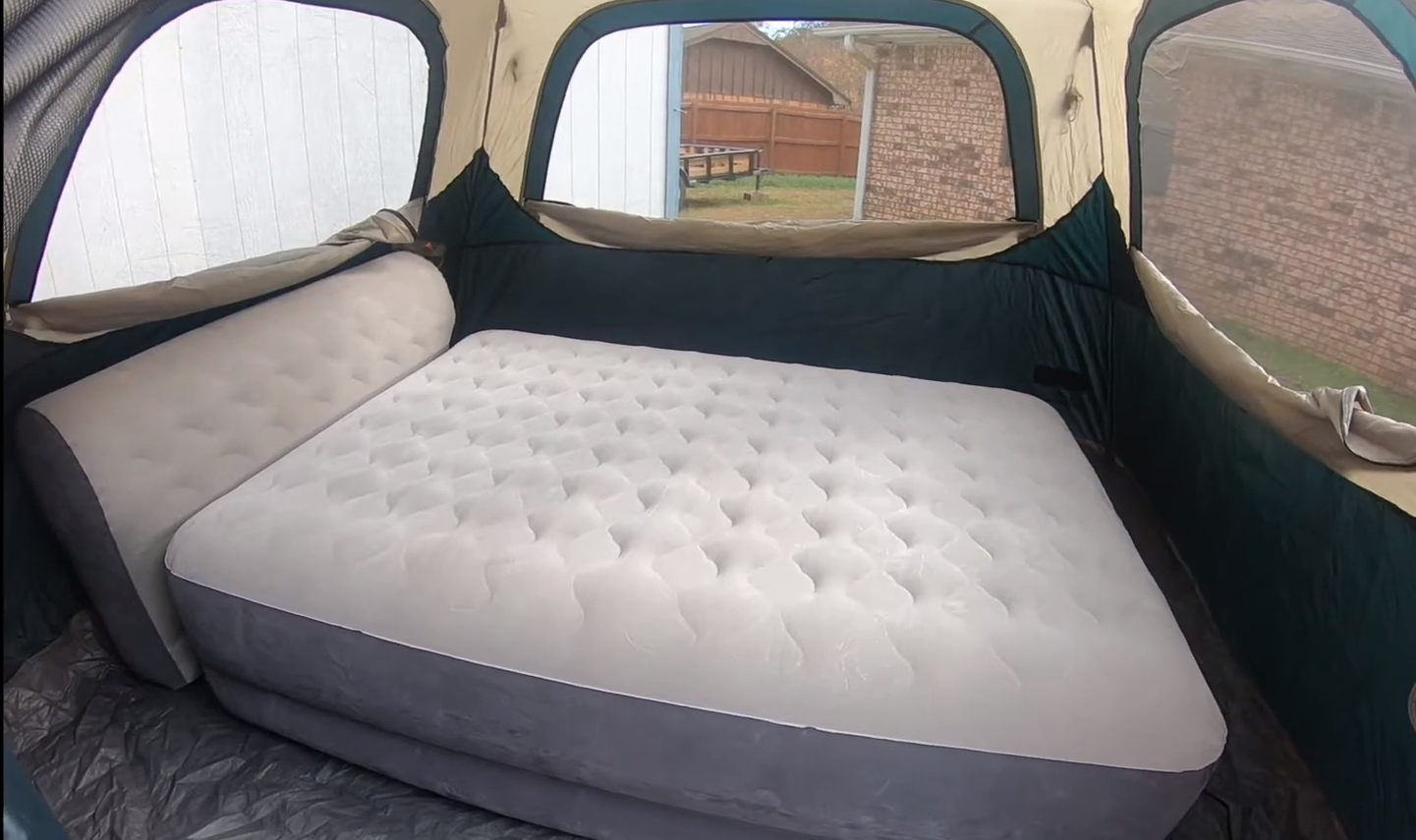
Re-Inflate And Enjoy Your Comfortable Sleep!
If you have an electric pump, you can plug it into a power source and get to work. Alternatively, if there is no available power, then manual pumps are ideal for the job. Depending on the size of the mattress it could take some time to fully inflate so be patient!
Make sure you don’t over-inflate as this will affect the comfort level and can potentially damage the material due to pressure building up within it. Once fully inflated, adjust its position in the tent until comfortable. [3]
Tips For Using An Air Mattress In A Tent
- Purchase a tent that is the right size for the mattress. Ensure to check if the tent’s floor area fits the mattress full size, as well as any extra items you may need in the tent.
- Invest in a good quality mattress with an appropriate height and width for the tent. An inflatable camping pad or other foam sleeping pads will provide added comfort when placed on top of the mattress.
- Double check that you have all necessary components such as a pump or battery-powered pump, repair kits, and extra valves before setting up the mattress. If you are unable to find these items at a store near you, be sure to shop online for them.
- Before inflating, ensure the bottom of your tent is clean and free from any sharp objects or debris that could puncture the mattress’s surface. Unroll it and set it up on a flat surface such as a tarp or blanket.
- Inflate the mattress using an air pump or battery-powered pump. Ensure to evenly inflate the entire surface area in order to get an even feel when lying down on top of it.
- Place the mattress inside the tent. Ensure to leave enough room for you and your camping partner to move around in the tent comfortably.
- After packing up your items, securely close all windows and doors of the tent for added warmth and protection from external elements such as wind, rain, and snow.
FAQ
Can you fit an air mattress in a tent?
Yes, you can. It is important to check the size of the tent and measure it against the mattress before purchasing one. You will need to ensure that the measurements match up so that the mattress fits comfortably inside the tent. [4]
Can a full size air mattress fit in a 2 person tent?
Yes, a full-size air mattress can fit in a 2-person tent if you buy one that is designed specifically for camping. These mattresses are usually made of materials that are lightweight and foldable so they can be easily stored or transported. They also come with built-in pumps so that you don’t have to inflate the mattress manually. In addition, many of these mattresses have attached straps or ties so that they stay securely fastened inside your tent. You may need to practice a few times before getting the right technique down. [5]
What size air mattress fits in a tent?
Most tents are designed to accommodate a twin-sized bed. However, if you have a larger tent or want to use a bigger sized mattress, there are options available and even those with extra height for more headroom. Just be aware that some models may not fit properly due to space limitations within the tent.
Ensure to measure both the interior of your tent and the mattress itself before making a purchase. Additionally, look into buying an inflatable camping pad to help maximize the sleeping surface within your tent. These pads are lightweight and come in a variety of sizes, so you can find one that fits both your budget and tent size!
How do I keep my air mattress from sliding in my tent?
One way to keep the mattress from sliding in the tent is by using a few anchor points. If the bottom of your tent has loops or grommets, you can use them to secure the mattress with ropes or straps. You should also consider getting an inflatable camping pad that fits underneath your air mattress for extra grip. Additionally, you can try putting small pieces of cloth underneath it, such as towels or rugs, to help prevent slipping and sliding. Finally, be sure to empty any pockets or compartments on the floor when setting up so that they don’t interfere with securing the mattress.
These are just some tips for keeping your air bed steady and secure inside your tent! Try out a few of these ideas and see which works best for you. With a little bit of effort, you can easily keep your mattress in place.
Useful Video: Coleman tent and air mattress
Conclusion
Once you’ve fitted your air mattress inside the tent, you should be ready to go! If you followed the tips outlined in this guide, you’ll have a comfortable and cozy place to sleep during the next camping trip. Before zipping up your tent for the night, make sure all of the connections are secure and that there is no chance of any air escaping from the mattress. An air mattress may take up more space than a regular sleeping bag but it will provide extra comfort and stability. If you need any help with the task, don’t hesitate to ask friends or family for assistance so your experience is as stress-free as possible. Happy camping!
References:
- https://campingvillas.com/fit-an-air-mattress-inside-a-tent/
- https://purehiker.com/fit-an-air-mattress-inside-a-tent/
- https://campingsquirrel.com/how-to-fit-an-air-mattress-inside-a-tent/
- https://mycampingfort.com/can-a-4-person-tent-fit-a-queen-air-mattress/
- https://outdoorsnug.com/what-size-air-mattress-fits-in-a-2-3-4-person-tent/

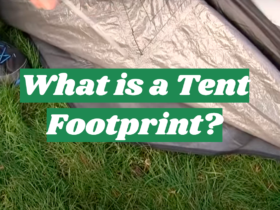

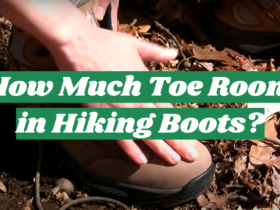

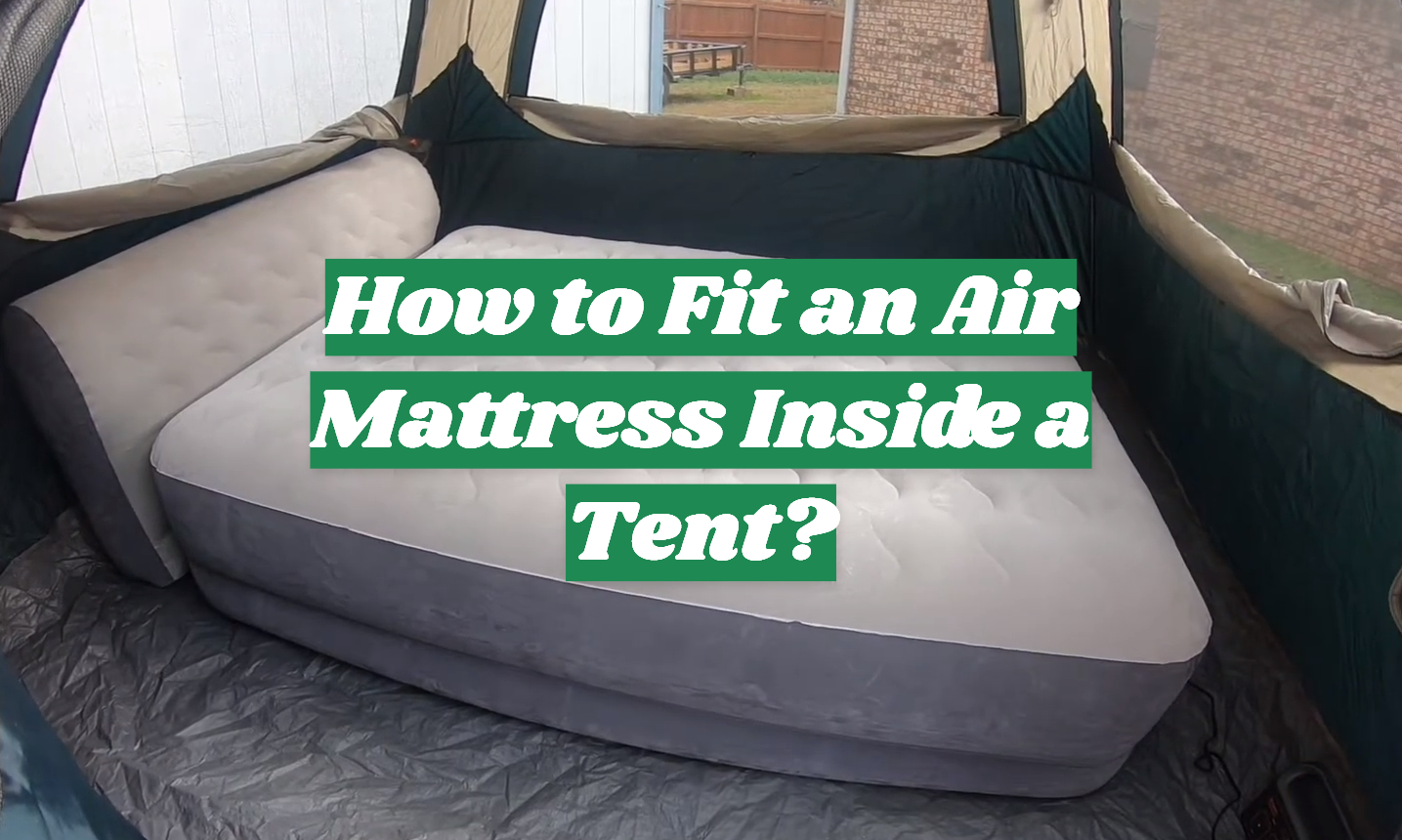
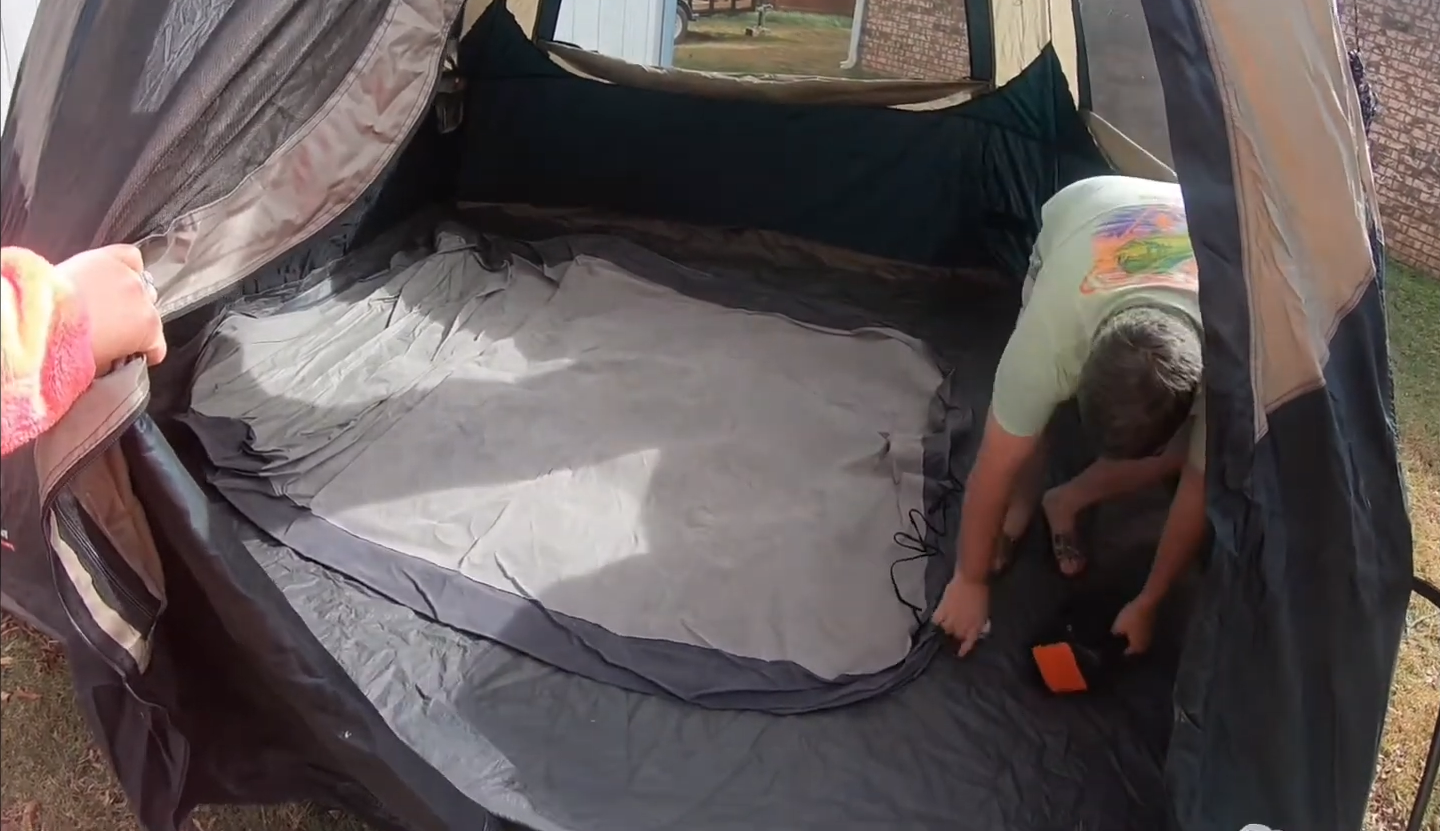

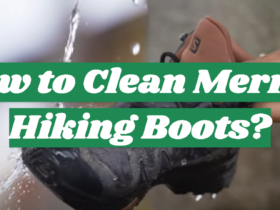
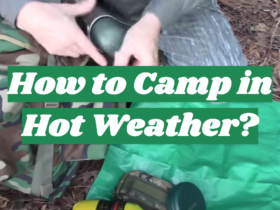
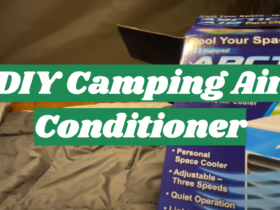
Leave a Review